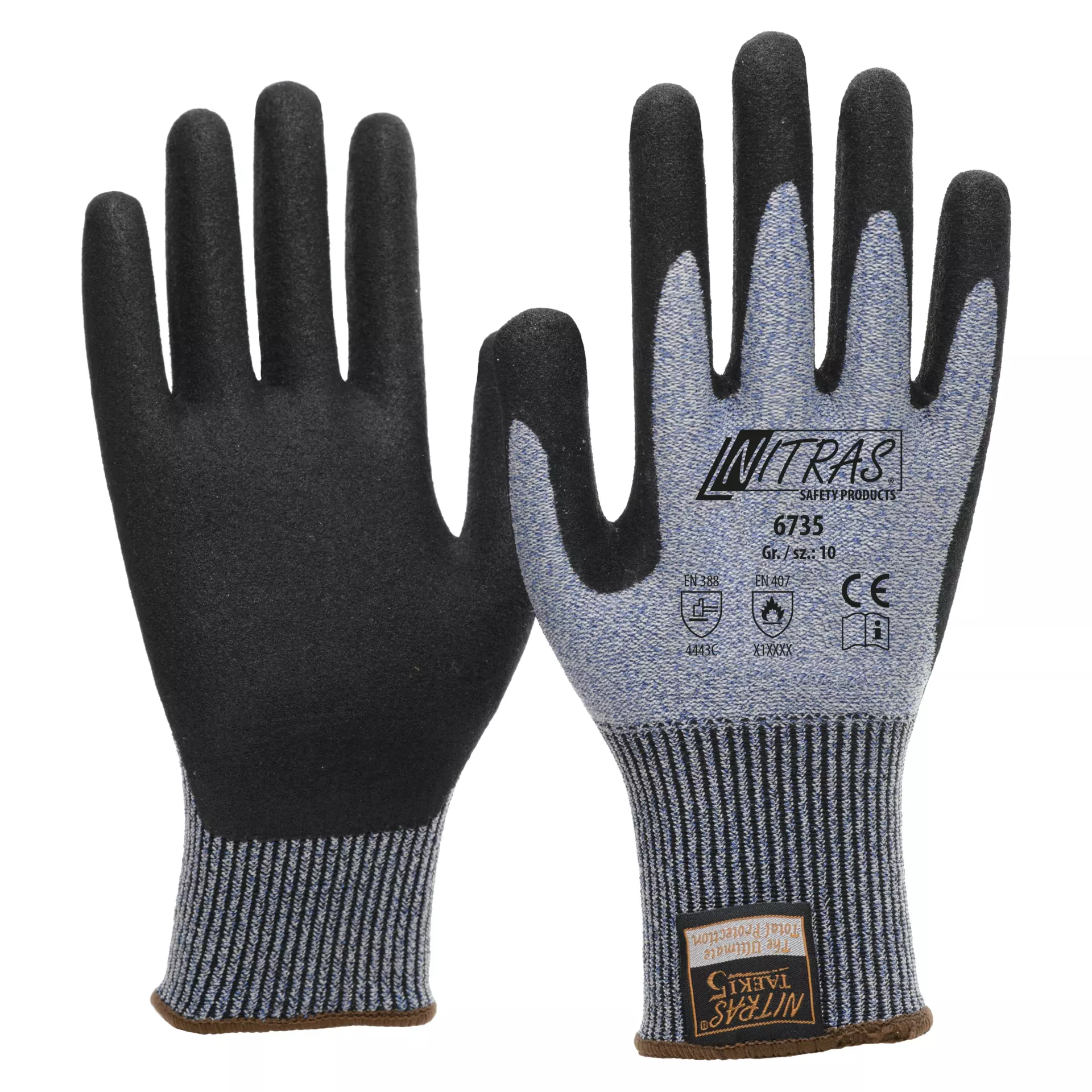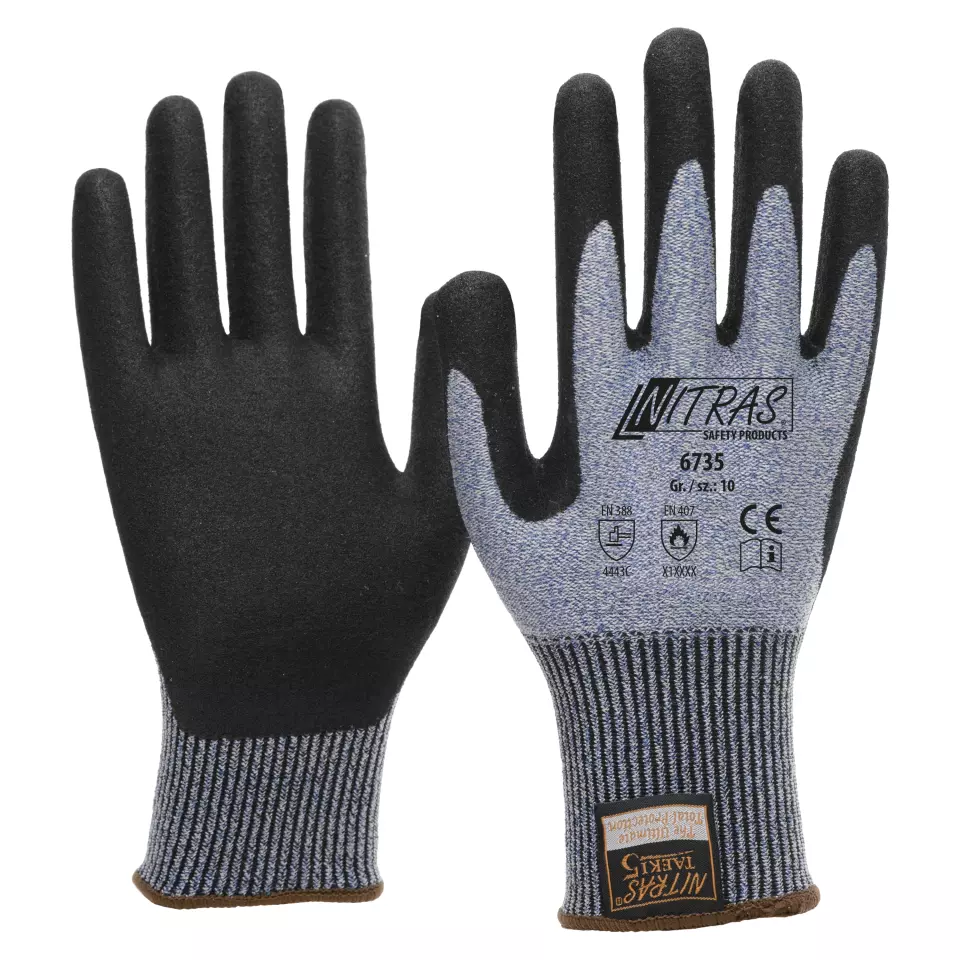

Features You'll Love

Coating Material · Nitrile foam
The substance applied to glove surfaces to enhance grip, durability, and protection, with different materials suited for various work conditions.

EN 388 · Tear Resistance Level 4, Abrasion Resistance Level 4, Cut Resistance, ISO 13997 Level C, Puncture Resistance Level 3
EN 407 · Burning Behaviour Level X, Heat Contact Level 1, Metal Splash Resistance Level X, Molten Metal Resistance Level X, Radiant Heat Level X, Heat Convection Level X
Offers the highest level of protection against tearing, withstanding a strong force before ripping.
Offers the highest level of protection against intense rubbing and wear from rough materials.
Offers medium protection against cut risks from handling lightweight metals and plastics.
Withstands strong pressure from sharp objects like nails or thick splinters.
This product has not been tested for its performance when exposed to an open flame. It is not rated for fire resistance and should not be used for protection against direct contact with flames.
Provides protection when briefly touching hot objects. Certified for contact with surfaces up to 100°C for at least 15 seconds, offering short-term protection against burns from items like hot cookware or machinery parts.
This product has not been tested for resistance against splashes of molten metal under the EN 407 standard. It does not offer rated protection for tasks where this is a risk, such as welding.
This product has not been tested for resistance against splashes of molten metal. It provides no claimed protection and should not be used for welding, foundry work, or other tasks with molten metal risks.
This product was not tested for protection against radiant heat, which is intense heat that can be felt from a distance. It does not claim to offer protection for tasks involving prolonged exposure to radiant heat sources.
This product was not tested for protection against convective heat, which is the transfer of heat through moving air, such as from a flame. Therefore, it has no claimed performance level for this specific thermal risk.
Nitras
TAEKI Cut protection Gloves, Blue, 10 pairs
TAEKI Cut protection Gloves, Blue, 10 pairs
5 / 5
42,09 €
Price per 10 pairs
4,21 € / pair
Choose size
Shipping fee is 7,95 € for orders under 80,00 €
Features You'll Love

Coating Material · Nitrile foam
The substance applied to glove surfaces to enhance grip, durability, and protection, with different materials suited for various work conditions.

EN 388 · Tear Resistance Level 4, Abrasion Resistance Level 4, Cut Resistance, ISO 13997 Level C, Puncture Resistance Level 3
EN 407 · Burning Behaviour Level X, Heat Contact Level 1, Metal Splash Resistance Level X, Molten Metal Resistance Level X, Radiant Heat Level X, Heat Convection Level X
Offers the highest level of protection against tearing, withstanding a strong force before ripping.
Offers the highest level of protection against intense rubbing and wear from rough materials.
Offers medium protection against cut risks from handling lightweight metals and plastics.
Withstands strong pressure from sharp objects like nails or thick splinters.
This product has not been tested for its performance when exposed to an open flame. It is not rated for fire resistance and should not be used for protection against direct contact with flames.
Provides protection when briefly touching hot objects. Certified for contact with surfaces up to 100°C for at least 15 seconds, offering short-term protection against burns from items like hot cookware or machinery parts.
This product has not been tested for resistance against splashes of molten metal under the EN 407 standard. It does not offer rated protection for tasks where this is a risk, such as welding.
This product has not been tested for resistance against splashes of molten metal. It provides no claimed protection and should not be used for welding, foundry work, or other tasks with molten metal risks.
This product was not tested for protection against radiant heat, which is intense heat that can be felt from a distance. It does not claim to offer protection for tasks involving prolonged exposure to radiant heat sources.
This product was not tested for protection against convective heat, which is the transfer of heat through moving air, such as from a flame. Therefore, it has no claimed performance level for this specific thermal risk.
Product description
Advanced cut protection gloves featuring TAEKI special yarn construction with nitrile foam coating for superior grip and control. These gloves offer exceptional cut resistance and contact heat protection up to 100°C for 15 seconds, while maintaining maximum dexterity with a Level 5 rating. The partial coating on palm and fingertips combined with a knitted wrist design ensures optimal handling precision and comfort during use.
Product Features:
- Partly coated palm and fingertips for enhanced grip
- Knitted wrist for secure fit
- High cut resistance
- Contact heat protection (100°C, 15 seconds)
- Maximum dexterity (Level 5)
Technical Details:
- TAEKI special yarn construction
- Nitrile foam coating
- Partial coating design
- Level 5 dexterity rating (EN ISO 21420:2020)
Standards:
- EN 388:2016+A1:2018 (4X43C)
—Abrasion resistance: Level 4
—Tear resistance: Level 4
—Puncture resistance: Level 3
—Cut resistance (TDM): Level C
- EN 407:2020 (X1XXXX)
—Contact heat resistance: Level 1